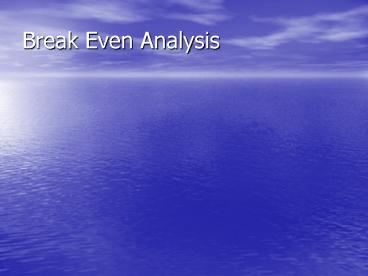Break Even Analysis PowerPoint PPT Presentation
Title: Break Even Analysis
1
Break Even Analysis
2
Break even
- Break even is a level of output and sales where
total costs equals total revenue - At this point the firms is making neither profit
nor loss - At output above break even the firm will be in
profit - At output below break even the firm will be
making a loss
3
Assumptions
- All other variables remain constant
- A single product is produced
- Costs can be divided into fixed and variable
elements - There is a linear (straight line) relationship
between output and total costs - variable costs
per unit remain unchanged - There is a linear relationship between output and
sales revenue each unit is sold at the same
price - All output can be sold at the given price
- The analysis applies to the relevant range only
4
Costs
- Fixed costs
- Do not rise with output
- Examples
- rent
- rates
- administrative costs
- interest payments
- Variable costs
- Rise as output rises
- Examples
- cost of materials
- labour costs
- Total costs fixed costs varable costs
5
Total revenue
- Also known as sales revenue or turnover
- Total revenue quantity sold x price per unit
- This rises as sales rise
- If we assume that price is uniform throughout
then there is a linear relationship between total
revenue and sales volume
6
Graphical analysis
Sales and costs ()
Sales revenue
Breakeven point
Sales revenue less Total costs profit
Total costs
Breakeven sales
Variable costs total costs less fixed costs
Total fixed costs
Sales / production (units)
Breakeven quantity
7
Notes on the break even graph (1)
- Fixed cost are shown as horizontal straight line
- Variable cost are added to the fixed costs
- Hence total costs start part way up the vertical
axis - Total sales revenue starts from the origin and
rise in the form of a straight line - Break even occurs at the intersection of total
costs and total revenue - We can read off both the break even quantity
(horizontal axis) and break even revenue
(vertical axis)
8
Notes on the break even graph (2)
- The triangles between the total cost and total
revenue curves are areas of loss (to the left of
break even point) or profit (to the right of the
break even point) - The actual profit or loss can be read off as the
vertical distance between total cost and total
revenue - The gap between current output and sales and
break even output and sales is known as the
margin of safety
9
Contribution
- Contribution is equal to Sales revenue minus
variable costs - This is not the same as profit since so far only
variable costs have been taken into account - Contribution per unit revenue per unit (i.e.
price) minus variable cost per unit - Contribution per unit can be regarded as that
units contribution to - Fixed costs and
- Profits
- Once fixed costs have been covered the
contribution is to profits
10
(No Transcript)
11
(No Transcript)
12
(No Transcript)
13
(No Transcript)
14
(No Transcript)
15
(No Transcript)
16
Rise in fixed costs
- The starting point for total revenue moves up the
vertical axis - The new total cost curve is parallel with the old
one but at a higher level - Break even occurs at a higher level
- sales volume
- sales revenue
- Profits are lower at each level of sales
17
Margin of safety
- This is equal to current output minus break even
output - Measures how far sales can fall before the
business starts to make a loss - Once break even output/sales is reached then the
contribution on each additional unit goes towards
profit - As a result we can calculate profits as follows
- Profit margin of safety x contribution per unit
18
Example 2
- Current output
7,500 units - Fixed costs
60,000 - Variable costs per unit 20
- Selling price per unit
32 - Contribution per unit ( 32 - 20) 12
- Break even output 6000/12 5000 units
- Margin of safety 7,500 - 5000 2,500 units
or 66.7 of current output - Profits marginal of safety x sales revenue
2,500 x 32 80,000
19
Target rate of profit
- We can adapt break even to calculate the level of
sales needed to reach a profit target - Treat the target level of profits as a kind of
fixed cost - Therefore output and sales needed to reach the
target level of profits - fixed costs profit target
- contribution per unit
20
(No Transcript)
21
(No Transcript)
22
(No Transcript)
23
(No Transcript)
24
(No Transcript)
25
Limitations of break even analysis
- Assumptions on which the analysis is based are
not valid - No costs are truly fixed -the divide between
fixed and variable costs is not clear cut - Cost curves are not necessarily linear. As output
rises it does not follow that there will be a
proportionate increase in sales - Takes no account of economies of scale and bulk
buying discounts - Production and sales are assumed to be the same
but it is unrealistic to assume that all output
is sold at and at a uniform price - It is a static model and needs to be reworked
whenever there is a change in anyone of the
variables - The analysis is only as good as the information
provided - It ignores outside variables such as the reaction
of competitors

